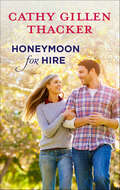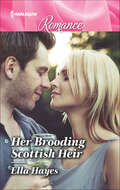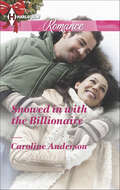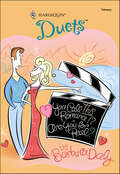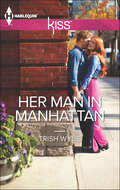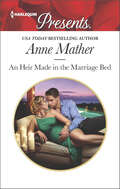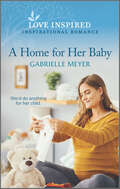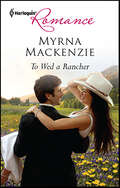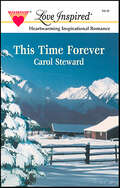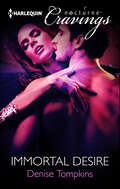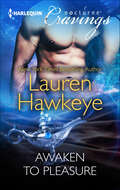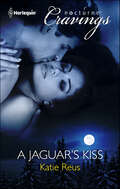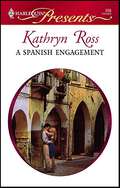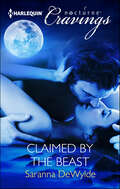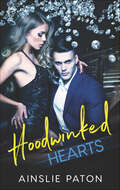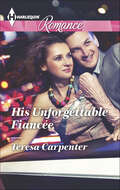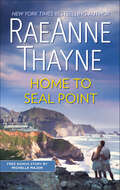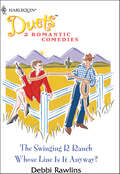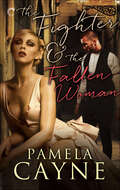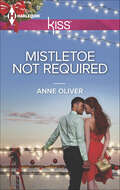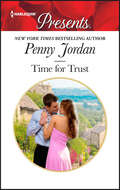- Table View
- List View
Honeymoon for Hire
by Cathy Gillen ThackerA fan-favorite story from bestselling Harlequin American Romance author Cathy Gillen Thacker!This marriage is anything but convenient!Dillon Gallagher felt he had an obligation to help Hayley Alexander, his friend's widowed wife. So when she mentioned wanting a real home for her baby daughter, it seemed only natural to have them move into his large house. In exchange for a place to stay, Hayley could cook and clean. What she ends up doing is tearing apart his fixer-upper!Living in such close quarters in a small town is all too much for local gossips. To curb the wagging tongues, Dillon proposes they marry-just until the renovations are complete. Then Hayley will buy the house from the undomesticated Dillon, and he can go back to his bachelor ways. But there's something about playing family that makes Dillon think he's ready to fall for his temporary honeymoon with Hayley-permanently!
Her Brooding Scottish Heir: A Diamond For The Single Mom Secret Millionaire For The Surrogate Resisting The Italian Single Dad Her Brooding Scottish Heir (Mills And Boon True Love Ser.)
by Ella HayesA kiss under the Northern Lights…Can it lead to forever?A cottage in the Scottish Highlands seems like the perfect retreat for artist Milla O’Brien. Only, running from the memories of her broken engagement, she arrives during a lavish wedding on the estate! Milla finds a kindred spirit in the bride’s brother and brooding heir, Cormac Buchanan. Happy-ever-afters seem as painful for the ex-soldier as they are for her. Could they heal each other’s hearts? Ella Hayes is the winner of the UK’s Prima magazine’s “Love To Write” competition 2017 in collaboration with Mills & Boon!
Unexpected Christmas Joy
by Gabrielle MeyerHoliday matchmakers are full of surprises…Her surprise inheritancecould make them a family.It’s a plot twist actress Kate LeClair never anticipated: becoming guardian to toddler triplets. But with guidance from experienced single dad Jacob Dawson, she and the boys can move on by Christmas. Pastor Jacob can’t ask Kate to swap stage lights for small-town Minnesota—even if he’s falling for her. But these tiny matchmakers might prove she’s found the only role she really wants…
Snowed in with the Billionaire
by Caroline AndersonOne magical Christmas Eve... Caught in a blizzard, Georgia Beckett is forced down a narrow lane she'd hoped to avoid...and not just because of the snow! The road takes her past the beautiful abandoned house of her youth-the new residence of her childhood sweetheart. Sebastian Corder's shocked to hear the doorbell ring-he never expected to see Georgia again. Nine years ago, both chasing different dreams, they went their separate ways. Now Sebastian's hand hesitates. Is he ready to open the door to the past? But the snow's getting heavier...and there's only one way to find out!
You Call This Romance!? and Are You for Real?
by Barbara DalyTwo lighthearted, sexy looks at what happens when fantasy and reality collide!You Call This Romance!? by Barbara Daly Lights, camera...oops!Cabot Brennen might be the sexiest man travel agent Faith Sumner has ever met, but she's not at all impressed by his idea of a romantic honeymoon. The jungle fantasy suite? Cameramen filming everything? And he has the gall to demand that Faith stand in for his betrothed, for a dry run. But the last straw is the fact that Faith would gladly put up with all of it, if she could be Cabot's bride....Are You for Real? by Barbara Daly Beauty and brains...what a curse!Chariiy Sumner is a scientist, not just another pretty face, and she intends to prove it! Disguising herself as a plain Jane, she ventures to win a position with the brilliant Dr. Jason Segal. But the only position Jason is interested in at the moment is horizontal. He wants a gorgeous woman to crave his body, not just his mind. Charity's more than willing to solve the devastatingy delicious doctor's problem, but how can she suddenly get real?
Her Man in Manhattan
by Trish WylieUp close and personal-with her bodyguard!It seems mayor's daughter Miranda Kravitz has scored herself a new and very dreamy bodyguard! Apparently the fireworks between them are scorching, but will this tabloid darling really be willing to give up her newfound taste for freedom-no matter how gorgeous Tyler Brannigan is?Rumor has it Brannigan hates playing by the rules and has used up all his strikes with the NYPD vice squad. So now this cop's paying his dues with a temporary assignment as babysitter. If anyone can keep this Manhattan princess in check, surely it's this tough-guy detective? Hopefully handcuffs won't be necessary!
An Heir Made in the Marriage Bed
by Anne MatherAn estranged married couple share a passionate night that results in an unexpected pregnancy in this romance from a USA Today–bestselling author.The inability to have a child left Joanna and Matt Novak’s passionate marriage in tatters. But when Joanna asks her tycoon husband for a divorce, Matt makes it clear he expects them to remain married . . . in the most intimate of ways!As tempers flare, the raging desire between them explodes—just once more, Matt and Joanna give in to the thrill of each other’s touch.In the shattering aftermath of their explosive encounter, they agree to part ways . . . until Joanna discovers one tiny consequence of their night together—she’s carrying Matt’s baby!
A Home for Her Baby
by Gabrielle MeyerShe’d do anything for her child.To secure their future…she must face the heartbreak of her past.Forced to sell her bed-and-breakfast, Piper Connelly’s happy to stay on as manager—until the pregnant widow discovers her former high school sweetheart is the buyer. While Max Evans has changed from the boy who once broke her heart, Piper’s not so sure about working with him. But what if the perfect home for Piper and her baby is right here with Max?From Harlequin Love Inspired: Uplifting stories of faith, forgiveness and hope.
To Wed a Rancher
by Myrna MackenzieLost in MontanaWhen Rachel Everly dumps her cheating boyfriend, he dumps her in a one-horse Montana town with only her suitcase and beloved camera! Then a deep, whisky-rough voice, straight out of a cowboy movie, offers her a way out...Rescued by the rancherShane Merritt plans to sell his parents' ranch, so he seizes the chance to hire Rachel as his photographer. At first, her enthusiasm for the dilapidated ranch bothers the taciturn cowboy, until he begins to see the woman who's putting the home back into his homestead in a whole new light!
This Time Forever
by Carol StewardBROTHER OF THE GROOMSJust when Adam MacIntyre answered his true calling at last, putting down roots on his Colorado ranch, along came footloose Lisa Berthoff to turn things upside down. His siblings might have marched down the aisle with hers, but Adam wasn’t about to fall for a drifter who didn’t believe in God, or in settling down....SISTER OF THE BRIDESAs a photojournalist, Lisa knew better than to let her personal feelings about a subject interfere with a job. But she couldn’t seem to help herself. Not when the subject was rugged cowboy Adam and the feelings were...well, she wasn’t quite sure what they were. That was the problem....
Immortal Desire
by Denise TompkinsBartending at Atlanta's hottest nightclub-side by side with what may be the world's hottest man-fuels Bailey's already overactive sex drive. So she’s beyond frustrated at her inability to reach orgasm by any means....Bar owner and incubus Griff knows all about Bailey's intense lust-because he feels it, too. So he’s taken it upon himself to ease her through the cataclysmic Change from mortal to immortal succubus. He tells himself it’s about saving her life, nothing more.But somewhere along the line, the purely physical passion they feel for one another has become something much more complicated....
Awaken to Pleasure
by Lauren HawkeyeHe'll grant her one wish.... What if she wishes for him?When Moira Connor stumbles across a jewel-encrusted silver trinket in the desert, she plans to trade it for food. Then the brush of her fingers unleashes a surprise....Freed from the lamp, Boone is bound to the woman who called him with her touch. She has one day to make a wish before he disappears forever. But Moira lives in the ruins of a world destroyed by witches. She hates magic-even when it comes in the shape of a dazzlingly gorgeous djinn. Will the exquisite pleasure of Boone's caresses be enough to earn Moira's trust? And will Moira be able to save Boone from the malevolent creature who would possess him?
A Jaguar's Kiss
by Katie ReusOwen Wright, alpha of his wolf pack, hasn't seen jaguar shifter Gabriela Segura in nearly ten years. She was his first love-until he did something to drive her away just as their relationship was heating up. Now Gabriela has returned to Montana, and his craving for her is stronger than ever.... But a recent string of brutal attacks on humans have the wolves suspicious of the jaguars, threatening the tenuous peace between the packs. Before he can claim Gabriela as his mate, they must join forces to prove her family's innocence and track down the true predator.
A Spanish Engagement
by Kathryn RossCarrie Michaels needs a fiancé—fast! Her life in Barcelona was turned upside down when she took on her orphaned niece, but now she can't imagine life without the little girl. However, when their future together is threatened there's only one answer: find a man and pretend she's engaged!Carrie can't believe her luck when sexy Spanish lawyer Max Santos discovers her dilemma and offers to help her out by becoming her fake fiancé. But little does Carrie realize that Max has needs of his own—one of which is a convenient wife!
Claimed by the Beast
by Saranna DeWyldeDr. Daphne Panetta is desperate to find a cure for a virus that turns its victims into zombie werewolves. Infected Konstantin Gevaudan should be nothing more than a test subject, but the only thing Daphne fears more than the beast within him is her own intense attraction to the virile man himself....When the research facility where he's being held goes up in flames, Konstantin has no choice but to take Daphne on the run with him. For the desire burning between them can mean only one thing: she is his true mate. But how can he claim her without changing her-forever?
Hoodwinked Hearts
by Ainslie PatonA master jewel thief meets his match in a daring romance of love and larceny... Confidence man, master thief and professional crook Cleve Jones knows a thing or two about risk. Ten years ago, he risked his freedom to fall in love with a dangerously sexy, foulmouthed, punk-ass professor's daughter and she disappeared, stealing his future happiness. Vegas hustler Aria Harp is back, she's in disguise, and she's snatched the famous diamond Cleve's been casing in a bold heist. She would've gotten away clean if her old nemesis hadn't figured out her sleight of hand and come after her. This time around, Aria's too smart to let Cleve break her heart, but he'll do anything to keep her safe. Even if it means a dirty double cross and losing the only woman he's ever loved-all over again. This book is approximately 29,000 words One-click with confidence. This title is part of the Carina Press Romance Promise: all the romance you're looking for with an HEA/HFN. It's a promise!
His Unforgettable Fiancée
by Teresa CarpenterHer million-dollar mystery man... Sheriff Grace Delaney's last case is a handsome stranger suffering from amnesia. She agrees to help him uncover his memory, but when his identity is revealed as multimillionaire playboy Jackson Hawke, Grace must swap the safety of her small town for the bright lights of Las Vegas and pretend she's his latest conquest! Grace soon finds herself falling, not for the millionaire, but the man she's come to know. But when Jackson's memory returns, will he forget her...or make her dreams a reality?
Unfinished Business: A Small Town Romance (Single Father Ser. #1214)
by Inglath CooperTwo animal lovers find romance in this classic wholesome story of companionship and dogs, from RITA® Award—winning author Inglath Cooper.Culley Rutherford is doing the best he can to raise his young daughter on his own. One night while at a conference in New York City, Culley runs into his old friend Addy Taylor. After a passionate night together, neither expects a lasting relationship…but then Addy moves back to their hometown to help her mother run their family orchard.Culley is willing to explore the attraction between them, but Addy is determined not to stick around any longer than necessary. Can Culley and his daughter, Madeline—with the help of a rescue puppy—show Addy that coming home for good is the best move she can make.Originally published in 2004.
A Love Worth Waiting For & Heaven Knows
by Jillian HartInspirational stories of small-town love by Jillian HartA Love Worth Waiting ForWealthy tycoon Noah Ashton lacks nothing but love…until a trip to his small Montana hometown leads him to gentle schoolteacher Julie Renton. Julie is reluctant to risk her heart, but when a shocking ordeal throws them together, Noah may prove to be the man she's always waited for.Heaven KnowsThe warm welcome she receives from a widower and his daughter is the last thing Alexandra Sims expected. John Corey could never turn away anyone in need, and he's determined to help—and love—Alexandra, in spite of the secret she hides.
Sweet Accord
by Felicia MasonLight, melodic tones. That was a worship service. Not guitar music! At least, Haley Cartwright believed that, and she was willing to do anything to prevent the new choir director from changing things. No matter that the man stirred up more than just Haley’s anger and made her yearn for things she had long given up on.…Matt Brandon had come to the small Oregon town to start over. He’d never expected to face an adversary like Haley. And though she protested she wanted him out of town, he saw how much his music touched her. Could he use his music to work through her fears and show her the blessings of love?
Home to Seal Point: Home to Seal Point
by RaeAnne ThayneEx-lovers are reunited by a terrible tragedy and must face their broken hearts head on in this classic tale originally published as Freefall in 2003 by New York Times bestselling author RaeAnne ThayneTen years ago, Sophie Beaumont had watched as her twin sister, Shelly, had chosen to marry a Canfield man, bear his children and be mistress of his manor. But now Shelly is dead—killed along with her husband, Peter, in a mysterious accident—and it’s Sophie who is left to raise those children, live at the Monterey mansion—and marry a Canfield man. Only this time the man is Thomas, Peter’s older brother. Because Peter is dead. Or is he? No body had ever been found. And Sophie and Thomas have unfinished business—a love affair, barely begun, cut off abruptly all those years ago. One that this time Thomas is determined to see bloom.…FREE BONUS STORY INCLUDED IN THIS VOLUME!Still the OneShe left him at the altar but an unexpected reunion might be just the thing to set them on the path to forever!Only a distress call could summon Lainey Morgan back to the small hometown she had run from, leaving the man she adored standing at the altar. Nothing in the ten years since had erased the pain of losing the baby Ethan Daniels had been marrying her for. Still, he always had been the best veterinarian around—and the stray dog that had attached himself to her needed attention. Almost as badly as she did. The years had only made Ethan want Lainey more. Both of them had done some growing up. Maybe this time, forever could be within their grasp…Originally published in 2013
The Swinging R Ranch and Whose Line Is It Anyway?
by Debbi RawlinsThe West will never be the same...The Swinging R Ranch by Debbi RawlinsBoston playboy Maxwell Bennett needs cash-fast! So he's thrilled when he inherits a ranch in Nevada...until he discovers that the ranch is actually a brothel and that the "ladies" are all over sixty (the R that's swinging stands for Retiree!). Suddenly, Max has more women than he can handle. But the only one he's interested in is beautiful Abby Cunningham, the town's next mayor. Only she wants nothing to do with The Swinging R. Or its new owner...Whose Line Is It Anyway? by Debbi RawlinsAttorney Taylor Madison is tired of the Boston rat race. She needs to slow down and appreciate the finer things in life. And oh-so-sexy rancher Clint Southwick is definitely fine! So, when they hit it off at Max's wedding, Taylor decides a little fling might be in order...until a mix-up with their cell phones leaves her wondering if Clint is as honest as he seems. But how can she expose the man when she's quickly losing her heart to him?
The Fighter & the Fallen Woman
by Pamela CayneIn this dark twist on Victorian romance, a champion fighter must risk it all for forbidden love and freedom.London, 1883"People like us don't get happy endings."In twelve years as a bangtail, Lady has never feared a man's kiss. Owned by the ruthless Hannibal Adams, the "Earl of the East End," she's draped in jewels and dead inside. Lady learns fear, however, when she kisses Mr. Adams's best fighter for luck—for King sees the real woman locked away behind finery and falsity.King's life is made of fists and scars, the only things that have ever felt real to him. Even his name came from the man who owns him—the man who turned him into a champion. From the moment Lady's kiss sends him reeling, King resists wanting what he can't have. Mr. Adams never gives up what he owns.When Lady is sent to nurse King through the tournament, she finds a new strength through the one man who's never treated her like a whore. King discovers that the woman who shares his dark world might also be the one to lead him out. And as the tournament comes to a violent finale, Lady and King must decide—stay spoiled and shackled, or break free and risk what happens when fear and dreams collide.104,000 words
Mistletoe Not Required
by Anne Oliver'Tis the season to be daring! This Christmas Olivia Wishart is determined to throw off the shackles of her past and have fun. And nothing says fun like a glamorous Christmas party! So, wearing a brand-new red dress and some seriously high stilettos, nervously clutching a glass of champagne, she's finally ready to start living life to the max.... Olivia had thought that pre-party nerves would be the only thing to get her heart racing...until a view even more spectacular than the glow of Sydney Harbor catches her eye. The drop-dead-gorgeous man with the steely black eyes is everything Olivia has ever wanted-and this Christmas she's not going to wait meekly under the mistletoe!
Time for Trust
by Penny JordanRead this classic romance novella by New York Times bestselling author Penny Jordan, now available for the first time in e-book! Tempted by the millionaire…Jessica Collingwood launched herself on a new career. She firmly believed that she had put the traumas of the past successfully behind her. Yet some shadows still lingered and she feared that even now her parents would somehow try to manipulate her and force her to return to the life-style she’d rejected. That’s why it was surprising when she fell head over heels in love with Daniel Hayward. Rich, attractive and successful, just the sort of man her parents would have chosen for her. He told her he loved her, but could Jessica trust him?Originally published in 1991
